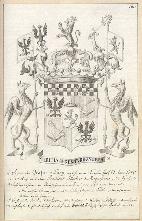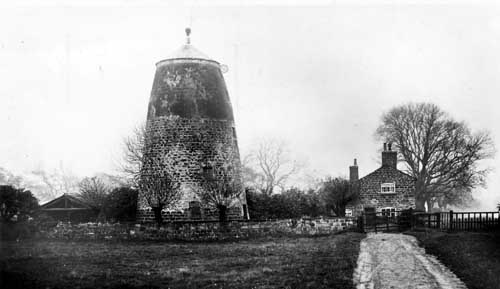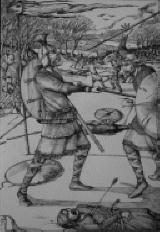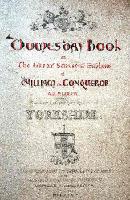Early History of Seacroft
We are indebted to the local historian Mr. John Gillenghan of the Skyrack Express for his invaluable assistance in composing this brief history of the Seacroft community.
The earliest historical account of Seacroft occurs as a result of the battle of Winwaed (Whinmoor) in 655 AD, which is recorded by the Veberable Bede, historian and monk of Jarrow, who was born in 673 AD. Bede records that King Oswy, a Christian ruler, and his army of Northumbrians, were successful in overcoming the much larger pagan army of the Mercians, led by King Penda who was killed in the course of the battle. Penwell Farm sited on Stanks Lane is reputedly named after the defeated Mercian King.
It is popularly held that the name “Seacroft” has Anglo-Saxon origins and means “field by a pool”; “saec” meaning pool or mire, and “croft” meaning field enclosure. Some claim, however, that another correct translation would be “sae” meaning battle, and “croft” meaning field; in which case the name Seacroft might originate from the 7th century battle between the Northumbrians and the Mercians to which the Venerable Bede refers in his writings. It is believed that, prior to Norman Conquest and during the last days of the Anglo-Saxon period, Seacroft enjoyed a degree of agricultural prosperity. However the Domesday Book of 1086 AD containing the results of the survey of England requested by William the Conqueror refers to “Sacroft” (Seacroft) as “waste wood pasture”.
 In the years following the Norman Conquest, Seacroft was held by the Somerville family as tenants of de Lacy of Pontefract. The entire parish of Whitkirk, which included Seacroft, had been granted by William the Conqueror to Albert de Lacy of Pontefract, founder of a powerful family who were Earls of Lincoln. The Somerville family continued at Seacroft until the mid 13th century. In 1285, Seacroft was held by the Earl of Lincoln, and by 1316 it was held by Thomas, Earl of Lancaster, executed in 1321. The Crown granted Seacroft estates to the son of John of Gaunt. He became Henry IV and inherited the de Lacy estates in 1399. Until 1603 Seacroft was part of the Duchy of Lancaster and in that year the King granted Seacroft to the 8th Baron Mountjoy, who became the Earl of Devon. The earl granted Seacroft to George Shillito and, after his death, the family conveyed Seacroft to James Nelthorpe in 1656. It remained with the Nelthorpe family until about 1811 when Seacroft was sold to John Wilson of Camp Hall, Leeds. It remained with the Wilson family until John’s great-grandson, Darcy Bruce Wilson, died unmarried in January 1931.
In the years following the Norman Conquest, Seacroft was held by the Somerville family as tenants of de Lacy of Pontefract. The entire parish of Whitkirk, which included Seacroft, had been granted by William the Conqueror to Albert de Lacy of Pontefract, founder of a powerful family who were Earls of Lincoln. The Somerville family continued at Seacroft until the mid 13th century. In 1285, Seacroft was held by the Earl of Lincoln, and by 1316 it was held by Thomas, Earl of Lancaster, executed in 1321. The Crown granted Seacroft estates to the son of John of Gaunt. He became Henry IV and inherited the de Lacy estates in 1399. Until 1603 Seacroft was part of the Duchy of Lancaster and in that year the King granted Seacroft to the 8th Baron Mountjoy, who became the Earl of Devon. The earl granted Seacroft to George Shillito and, after his death, the family conveyed Seacroft to James Nelthorpe in 1656. It remained with the Nelthorpe family until about 1811 when Seacroft was sold to John Wilson of Camp Hall, Leeds. It remained with the Wilson family until John’s great-grandson, Darcy Bruce Wilson, died unmarried in January 1931.
Leeds parish register records the burial on 1 April 1643 of “Captaine Boswell, slayne at Seacroft battell”. This Civil War casualty resulted from the move towards Leeds, via Bramham Moor, of the forces of Thomas Lord Fairfax. Fairfax, who along with Cromwell had formed the “New Model Army” during the Civil War, was in the act of marching a small unit of soldiers from Tadcaster to Leeds. When he reached the entrance to Seacroft, his group were attacked by Royalist forces of the Duke of Newcastle and forced to retreat to Bramham Moor in order to re-group.
 It is thought that Seacroft Hall was probably built in the 17th Century by the Shillito family, although there are references to the “site of the manor, hall, chamber, granges” in 1341. The hall once had a large ornamental pond, which was filled in to form Parklands High School sports field. Foxwood school occupied the buildings of Parklands School for two years, prior to opening as the first comprehensive school in Leeds in September 1959. The official opening ceremony was conducted by Hugh Gaitskell MP on 5th February 1960.
It is thought that Seacroft Hall was probably built in the 17th Century by the Shillito family, although there are references to the “site of the manor, hall, chamber, granges” in 1341. The hall once had a large ornamental pond, which was filled in to form Parklands High School sports field. Foxwood school occupied the buildings of Parklands School for two years, prior to opening as the first comprehensive school in Leeds in September 1959. The official opening ceremony was conducted by Hugh Gaitskell MP on 5th February 1960.
Seacroft Hall was finally demolished in June 1953 after 20 years of being unoccupied. In 1937, Leeds City Council had suggested that the Hall park, woodlands footpaths and open spaces should be “preserved in the development of the Seacroft estate”. The council retained many of the hall’s contents, including a Georgian fireplace which was placed in Temple Newsam house in the late 1930’s, and later passed to Leeds City Museum. In March 1994, the fireplace was placed on permanent loan in the Tetley’s Brewery Wharf Museum where it is a major feature of the Georgian dining room.
 The first Wesleyan Chapel in Seacroft was built in 1751 and a part of the original walls do help to form the structure of the present-day Seacroft Methodist Church. The Chapel was rebuilt in 1821, and enlarged in 1840 and 1874. Charles Wesley came to Seacroft in October 1756, followed by his brother John Wesley on 25th July 1761. The new wing to the north of Seacroft Methodist Church was opened on 24th May 1980 by Paul Long and dedicated by the Revd Stanley Rose, Chairman of the Leeds District.
The first Wesleyan Chapel in Seacroft was built in 1751 and a part of the original walls do help to form the structure of the present-day Seacroft Methodist Church. The Chapel was rebuilt in 1821, and enlarged in 1840 and 1874. Charles Wesley came to Seacroft in October 1756, followed by his brother John Wesley on 25th July 1761. The new wing to the north of Seacroft Methodist Church was opened on 24th May 1980 by Paul Long and dedicated by the Revd Stanley Rose, Chairman of the Leeds District.
North of the Green is Seacroft Grange, built in 1627, which became the home of the Tottie family. Having been known as “Tottie Hall”, it became Seacroft Grange, and the property of John Wilson, in 1837. It was leased to tenants including Dr. William and Mrs Sarah Pogson, and Constance Eade, the sister of Darcy Bruce Wilson. Seacroft Grange became the property of Leeds City Council in 1931, on the death of Darcy Bruce Wilson, and was made a listed building in 1951.
Dr. Pogson occupied the Grange at the turn of the century. He was the Seacroft Doctor from November 1872 until his death on 9th November 1912 aged 75. His wife Sarah was the daughter of John Townend of Park Farm, Seacroft, a farmer and maltster who was overseer and estate agent to Darcy Bruce Wilson. Sarah died in September 1928.
Dr. Pogson became a skin specialist with patients from all over Britain. He offered specialist advice to King Edward VII and developed a skin soap known as “Dr. Pogson’s Soap”, maufactured by the Whitehall Soap Works and sold in pink wrappers at 1/6d a tablet. Pogson left much property, including the old almshouses, popularly known as “Pogson’s Cottages”. He was buried at Saint James’ Church, having been both people’s warden and Vicar’s warden during his active life.
 Seacroft Windmill was owned by the Wilson family in the mid-19th century and rented to James Pearson. It is suggested that the mill could be the flint mill mentioned by John Smeaton in 1774, and was one of several local tower mills grinding corn. In 1822, William Chippindale moved from Yeadon to Seacroft mill and it is said that, on his 80th birthday in 1842, he stood on his head on top of Seacroft mill to show that his health was good.
Seacroft Windmill was owned by the Wilson family in the mid-19th century and rented to James Pearson. It is suggested that the mill could be the flint mill mentioned by John Smeaton in 1774, and was one of several local tower mills grinding corn. In 1822, William Chippindale moved from Yeadon to Seacroft mill and it is said that, on his 80th birthday in 1842, he stood on his head on top of Seacroft mill to show that his health was good.
West of the Green is the early 19th century “Cricketer’s Arms” public house. At one time a coaching inn complete with stables, it was sold in 1931 with its own brewhouse as part of the Wilson estate.
Seacroft Village Hall was opened on 6th January 1934 as the Darcy Bruce Wilson Institute, by Colonel C. Eade. He was the nephew of Darcy Bruce Wilson, who had left £1000 in his will for the land and new hall.
The old “Lion and Lamb” inn closed on 4th September 1958 and the key is preserved in the new “Lion and Lamb” public house which opened in 1958 as the “Seacroft”. The name was adopted in 1983 following a ballot of customers. Mansfield brewery took over the licence in the same year.
The Ring Road Seacroft by-pass was opened in 1964. The adjacent Coal Road was once used by tenant farmers on Harewood estate who delivered coal to Harewood House from the Coal Staithe of the Waterloo Colliery.



